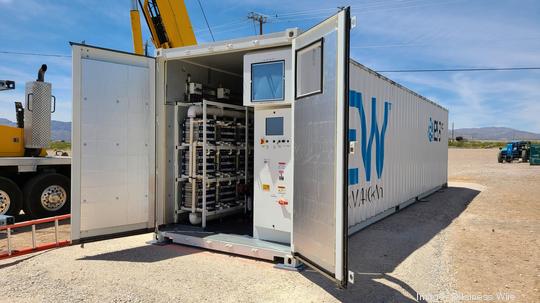
Revenue continues to be sparse for ESS, the Portland-area battery energy storage company that went public in 2021. But unlike many of its brethren from the SPAC-boom era, it still has cash to pursue its ramp-up.
The company (NYSE: GWH) this week reported $371,000 in revenue on sales of two Energy Warehouse units in the first quarter. It had a net loss of $21.9 million.
That chipped away at cash and short-term investments, which stood at $119 million at quarter’s end. ESS had about $250 million upon going public in October 2021.
ESS is trying to edge into an energy-storage market dominated by lithium-ion systems with an alternative technology called a flow battery. A chief selling point is longer duration output.
The company’s main focus the past 19 months has been on building out an automated factory in Wilsonville, where it has its headquarters.
ESS 2022 revenue of $899,000
Nonetheless, the company has been slower to grow than projected when its SPAC deal was announced in spring 2021. In presentations then, ESS and its special purpose acquisition company partner forecast $37 million in revenue in 2022, rising to $300 million in 2023. ESS reported revenue of $899,000 in 2022.
Similar sales-growth shortfalls have left dozens of companies that went the SPAC route “running out of cash, joining at least 12 that have already gone bankrupt,” a recent Wall Street Journal analysis reported.
As the Journal noted, shares for many businesses that did SPAC deals have fallen sharply. Most of the companies went public with their stock around $10, and some have sunk below $1 — such as Vacasa (Nasdaq: VCSA), the Portland-headquartered vacation rental company. That’s brought the threat of delisting and made raising money difficult and expensive.
ESS fell as low as $1.01 at one point this year and closed Thursday at $1.13. Cash isn’t an immediate concern, CFO Tony Raab said in a call with investment analysts this week.
“We have retooled our operating plans going forward to optimize and scale our production processes, and in doing so, have extended our cash runway,” Raab, who joined the company last November, said. “We believe we have sufficient capital to support our plans for 2023 and take us into 2024.”
Problem with legacy contracts
One challenge for ESS has been recognizing revenue on deliveries, a process complicated by legacy contracts that “put a greater onus on ESS to have project-level responsibility … including items like completed system-level deliverables and site acceptance testing post commissioning,” Raab said.
More standard terms adopted last year should speed revenue recognition, he said.
This last quarter, ESS also suffered from unexpected delivery delays. Ten units bound for Australia were shipped, but project issues prevented delivery.
“We have also built nine additional energy warehouses in Q1 for that project,” CEO Eric Dresselhuys said, “but given the project delays, we are waiting to ship the units until we receive clarity on project timing.”
Overall, the CEO painted a picture of ESS as grinding through growing pains while positioning itself to seize a long-duration energy storage opportunity aided by incentives in the Inflation Reduction Act:
“Although we expect it will take some time to realize the full benefits of these tailwinds, we are already seeing significant increase in customer activity as the entire energy system prepares for a surge in energy storage deployments. ... Launching a transformative technology has many challenges and we are working diligently to address those we've discussed today. I am pleased that we are making good progress, but we recognize the work we have yet to do to improve revenue recognition and scale our manufacturing.”
Editor's note: This story was updated to correct that the delayed shipments cited by ESS were to ESI in Australia, not the Schiphol Airport in Amsterdam.



